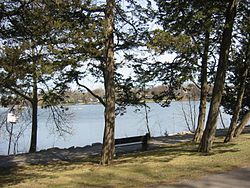Cedar Lake (Minneapolis)
| Cedar Lake | |
|---|---|

View from the west shore (early spring 2006). The shore is lined with Eastern Red Cedar trees that give the lake its name, the IDS Center is visible in the background.
|
|
| Location |
Minneapolis, Minnesota, United States |
| Coordinates | 44°57′37″N 093°19′16″W / 44.96028°N 93.32111°WCoordinates: 44°57′37″N 093°19′16″W / 44.96028°N 93.32111°W |
| Basin countries | United States |
| Surface area | 169 acres (68 ha) |
| Max. depth | 51 ft (16 m) |
| Surface elevation | 853 ft (260 m) |
Cedar Lake is a lake on the west side of Minneapolis, north of Lake Calhoun and west of Lake of the Isles. The lake is surrounded by parkland on the west side, while the east side borders the Kenwood residential area. The north side is bordered by the Cedar Lake Trail and the BNSF Railway. The lake has an area of 169 acres (0.26 sq mi) and a maximum depth of 51 feet (16 m).
Cedar Lake is part of the Grand Rounds Scenic Byway, connecting with Theodore Wirth Park on the north end and Lake Calhoun and Lake of the Isles on the south end via the parkway system. The Cedar Lake Trail, on the north shore of the lake, serves as both a recreational trail and a link for non-motorized commuters to reach downtown Minneapolis. It has three separate paths: one for pedestrians, one for westbound bicyclists and skaters, and another for eastbound bicyclists and skaters each being about 2 miles in distance by the lake. Other trails around the lake include separate bicycle and pedestrian trails on the west side of the lake, and the Kenilworth Trail a short distance off the east side of the lake. Cedar Lake is also popular for canoeing and swimming, with three official swimming beaches. Notable is "Hidden Beach", officially named East Cedar Beach, located on the northeast side of the lake.
The lake contains black bullhead, black crappie, bluegill, bowfin, green sunfish, hybrid sunfish, largemouth bass, northern pike, pumpkinseed, tiger muskellunge, walleye, white sucker, and yellow perch. Some fish consumption guideline restrictions have been placed on the lake's bluegill, carp, crappie, largemouth bass, northern pike, and walleye due to mercury and/or PFOS contamination.
...
Wikipedia
